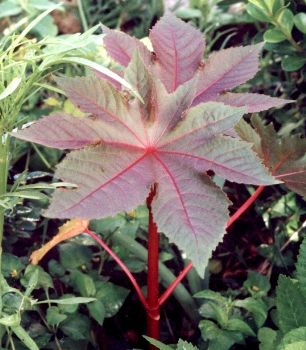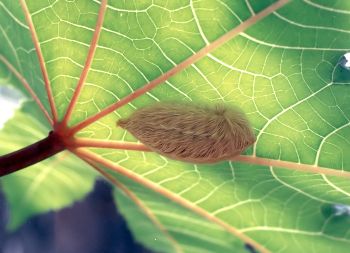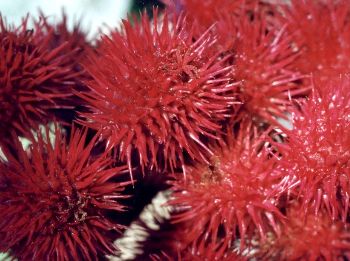Castor Bean
by Valerie (June 1, 2000)
revised August 24, 2003
  Sometimes we have varying luck with certain plants, especially annuals, which must be reseeded every year. Actually, at times castor bean plants (Ricinus sp.) have survived through the winter without freezing all the way down (which kills them) and the following summer would resprout from the base and grow to be about eight feet tall. This is the exception, though, and usually they have to be started from seed after the freezes are over. The extremely hot and dry weather also seems to take its toll on the plants, sometimes stunting them so that they never have time to set seed before a freeze kills them. Some seeds don't sprout until the following year, having skipped a whole season, which is a help when the previous year's crop failed to reproduce. Sometimes we have varying luck with certain plants, especially annuals, which must be reseeded every year. Actually, at times castor bean plants (Ricinus sp.) have survived through the winter without freezing all the way down (which kills them) and the following summer would resprout from the base and grow to be about eight feet tall. This is the exception, though, and usually they have to be started from seed after the freezes are over. The extremely hot and dry weather also seems to take its toll on the plants, sometimes stunting them so that they never have time to set seed before a freeze kills them. Some seeds don't sprout until the following year, having skipped a whole season, which is a help when the previous year's crop failed to reproduce.
When they do grow, castor beans are beautiful, with huge lobed leaves and brilliant red flowers and seed pods. The kind of castor bean we usually grow has red stems and veining on the leaves, but there is also a completely green variety, for which I received seeds once. Both kinds did poorly that year and we don't have the green type anymore.
Castor oil is obtained from the seeds but the rest of the plant is considered to be extremely poisonous. It is not bothered by insect pests much so the foliage usually looks very nice.
One summer, during which the castor beans were growing quite well, we discovered several puss caterpillars, or asps (Megalopyge opercularis), on the plants. These are the larvae of the flannel moth and we've never seen them before or since. The caterpillars were all about an inch long and we didn't touch them, since we knew that they have poisonous spines under the long hairs.
 |
